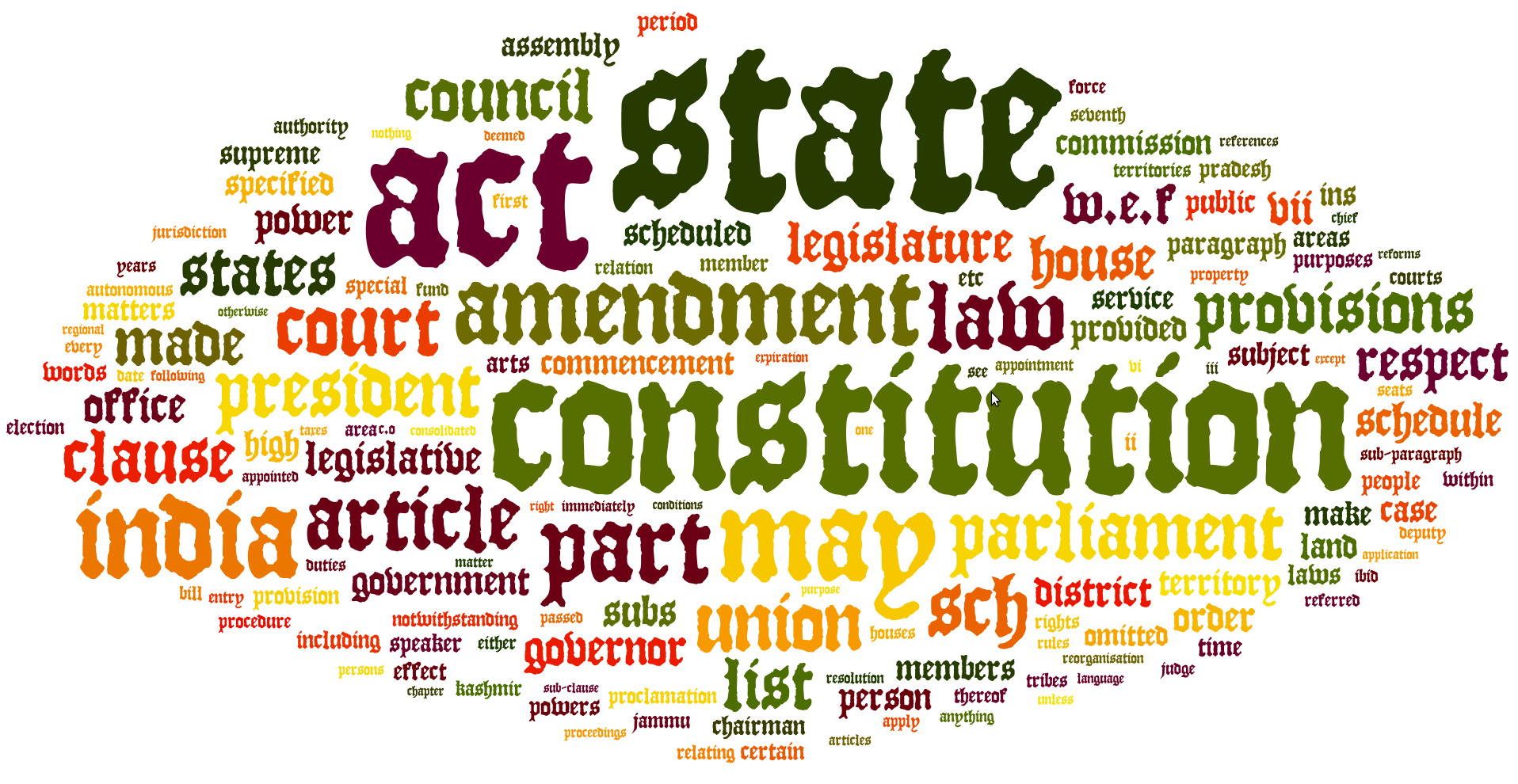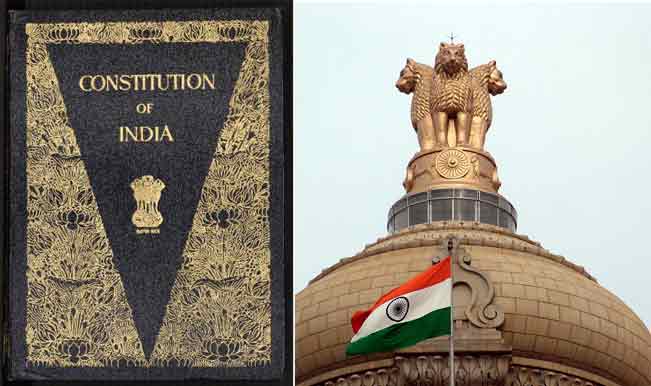Dear Readers,
Here we are providing the Notes on Indian Constitutional Amendments, that will be continued till completion of Topic.
Today we are providing the Introduction with ten Constitutional Amendments. Hope that all of you will appreciate it.

The
procedure of amendment makes the Constitution of India neither totally
rigid nor totally flexible, rather a curious mixture of both. Some
provisions can be easily changed and for some others, special procedures
are to be followed. Despite the fact that India is a federal state, the
proposal for amending the Constitution can be initiated only in the
House of the Union Legislature and the State Legislatures have no such
power. In fact, there are three methods of amending the Constitution.
But Article 368 of the Constitution which lays down the procedure for
amendment mentions two methods:

1. An
amendment of the Constitution may be initiated only by the introduction
of a Bill for the purpose in either House of Parliament and when a Bill
is passed in each House.
(i) By a majority of total membership of that House.
(ii) By a
majority of not less than two-thirds of the members of that House
present and voting, it shall be presented to the President who shall
give his assent to the Bill and there upon the Constitution shall
stand amended in accordance with the term of the Bill. Most of the
provisions of the Constitution can be amended by this procedure.
2. For amending certain provisions a special procedure to be followed,
(i) A Bill for the purpose must be passed in each House of Parliament by a majority of total membership of the House,
(ii) By a majority of not less than two-thirds of the members of that house present and voting and

(iii) It
should be notified by the legislatures of not less than one-half of the
States before the Bill is presented to the President for assent. The
provisions requiring this special procedure to be followed include-
(a) manner of the election of the President,
(b) matters relating to the executive power of the Union and of the State,
(c) representation of the States in Parliament
(d) matters relating to the Union Judiciary and High Courts in the States
(e) distribution of legislative powers between the Union and the States
(f) any of the List in the Seventh Schedule
(g) provisions of Article 368 relating to the procedure for amendment of the
Constitution, etc.
3. There
are certain provisions which require simple majority for amendments.
They can be amended by the ordinary law making process. They include
(a) formation of new States and alteration of areas, boundaries or names of existing ones
(b) creation or abolition of Legislative Councils in the States
(c) administration and control of Scheduled Areas and Scheduled Tribes
(d) the salaries and allowances of the Supreme Court and High Court Judges
(e) laws regarding
citizenship, etc. It is significant that the laws passed by Parliament
to change the above provisions would not be deemed to be amendments of
the Constitution for the purpose of Article 368.
Some important amendments are:
The Constitution (First Amendment) Act, 1951

In June 1951, the Constitution (First Amendment) Act was passed, and the following Amendment in the Constitution were inserted :
(i) To Article 15, a new clause (4) was added: (ii) clauses (2) and (6) of Article 19 were recast; (iii) After Article 31, Article 31A and 31B were inserted; (iv) For original Article 85, a new Article was substituted; (v) In Article 87, clauses (1) and (2) were recast; (vi) For the original Article 174, a new Article was substituted; (vii) In Article 176, clauses (1) and (2) were recast: (viii) Clause (1) of Article 341 was recast; and similarly, clause (1) of Article 342, sub-clause (a) of Article 342, sub clause (a) of clause (3) of Article 372, and clause (1) of Article 376 were also recast; (ix) After the Eighth Schedule to the Constitution a Ninth Schedule was added and thirteen laws passed by State Legislatures were included in it so that those Acts might not be challenged in courts.
The
main purpose of the Amendment was the removal of certain practical
difficulties created by court decisions in several cases such as
Kameshwar Singh vs. State of Bihar, Romesh Thapar vs. State of Madras,
Brij Bhusan vs. State of Delhi and Motilal vs. Government of Uttar
Pradesh. The issues involved in these cases were numerous, such as the
scope of the fundamental right of freedom of speech, acquisition of
Zamindari (land) of intermediaries, conflict between a citizen’s
fundamental right to practise any profession, or to carry on any
business or trade (Article 19) and State monopoly of any trade, and so
on.
The Constitution (Second Amendment) Act, 1952
The Second
Amendment, amended Article 81 in order to remove the prescribed limit of
7,50,000 of the population for one member to be elected to the Lok
Sabha. According to the original provision, at least one member was to
be elected to the Lok Sabha for every 7,50,000 of the population. It was further provided that the maximum number of elected member to the Lok Sabha should not exceed 500.

The Constitution (Third Amendment) Act, 1954
The Third Amendment
brought about changes in the Seventh Schedule consisting of the three
Legislative Lists and entry 33 of the Concurrent List was substituted by
a new one.
The Constitution (Fourth Amendment) Act, 1955
Article 31 and 31A
were amended by the Constitution Fourth Amendment Act. Clause (2) of
Article 31 clause (1) of Article 31A were substituted by new clauses. As
a result of these, the adequacy of the quantum of compensation paid for
the compulsory acquisition of property for ‘a public purpose’ could not
be questioned in a court of law. It also amended Article 305 and the
Ninth Schedule.
The Constitution (Fifth Amendment) Act, 1955
The Constitution (Fifth Amendment) Act amended Article 3. In the Constitution there was
no time limit during which a State Legislature should express its boundaries, which the Centre may like to make. With the help of this amendment, it was provided that the State will be required to express its views on such matters within such period as may be specified in the reference or within such further period, as the President may allow.
The Constitution (Sixth Amendment) Act, 1956
In this Act, the Seventh Schedule to the Constitution was amended and in the Union
List, a new entry was added after Entry 92 in the State List, a new Entry was substituted for Entry 54. It also amended Articles 269 and 286 dealing with inter-state Sales-tax.
The Constitution (Seventh Amendment) Act,1956
The Seventh Amendment brought about the most comprehensive changes so far in the Constitution. This amendment was designed to implement the State Reorganisation Act. The Second and Seventh schedules were substantially amended for the purpose of the States Reorganization Act.
The Constitution (Eight Amendment) Act, 1959

The Act extended the period of reservation seats in Lok Sabha and State Legislatures for the Anglo-Indians, the Scheduled Castes and Scheduled Tribes by another 10 years.
The Constitution (Ninth Amendment) Act, 1960
It provided for the transfer of certain territories of India to Pakistan under an agreement between India and Pakistan as a part of a comprehensive settlement of border disputes
between the two countries.
The Constitution (Tenth Amendment) Act, 1961
The Tenth Amendment integrates the areas of Free Dadra and Nagar Haveli with the Union of India and provides for their administration under the regulation making powers of the President.


Post a Comment
Post a Comment